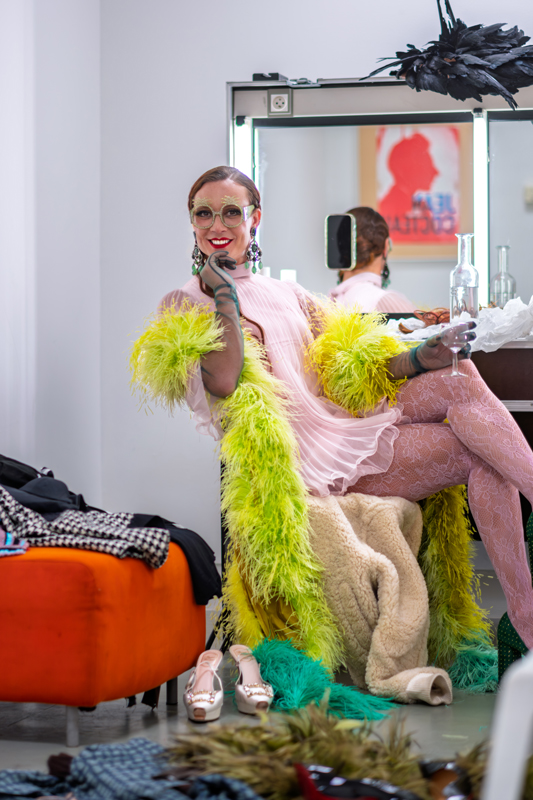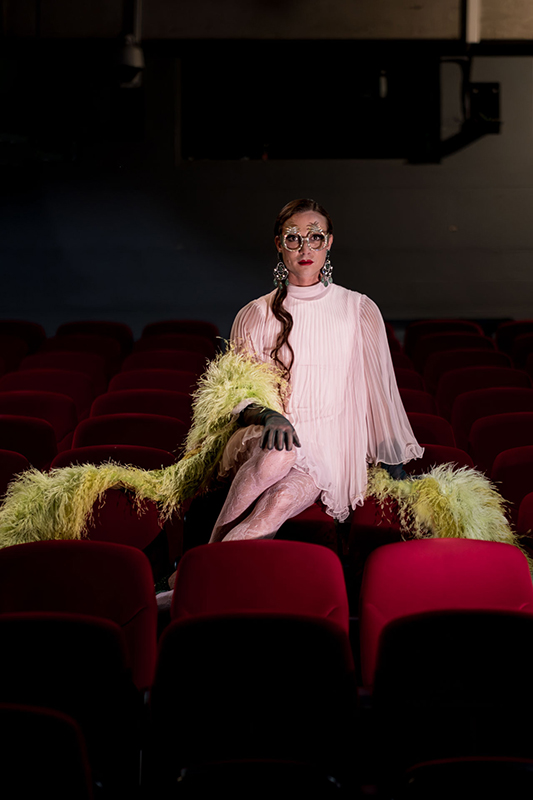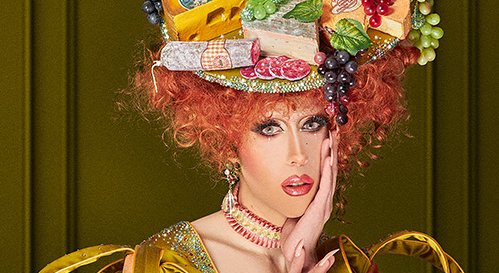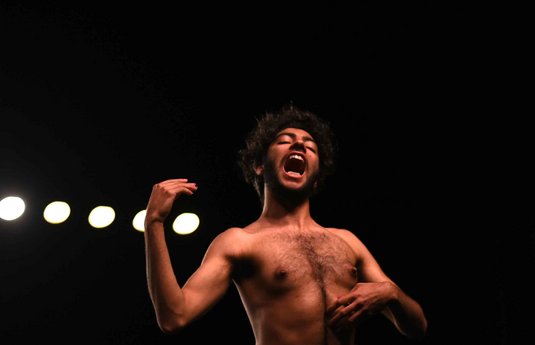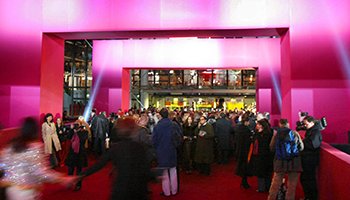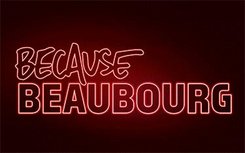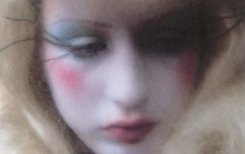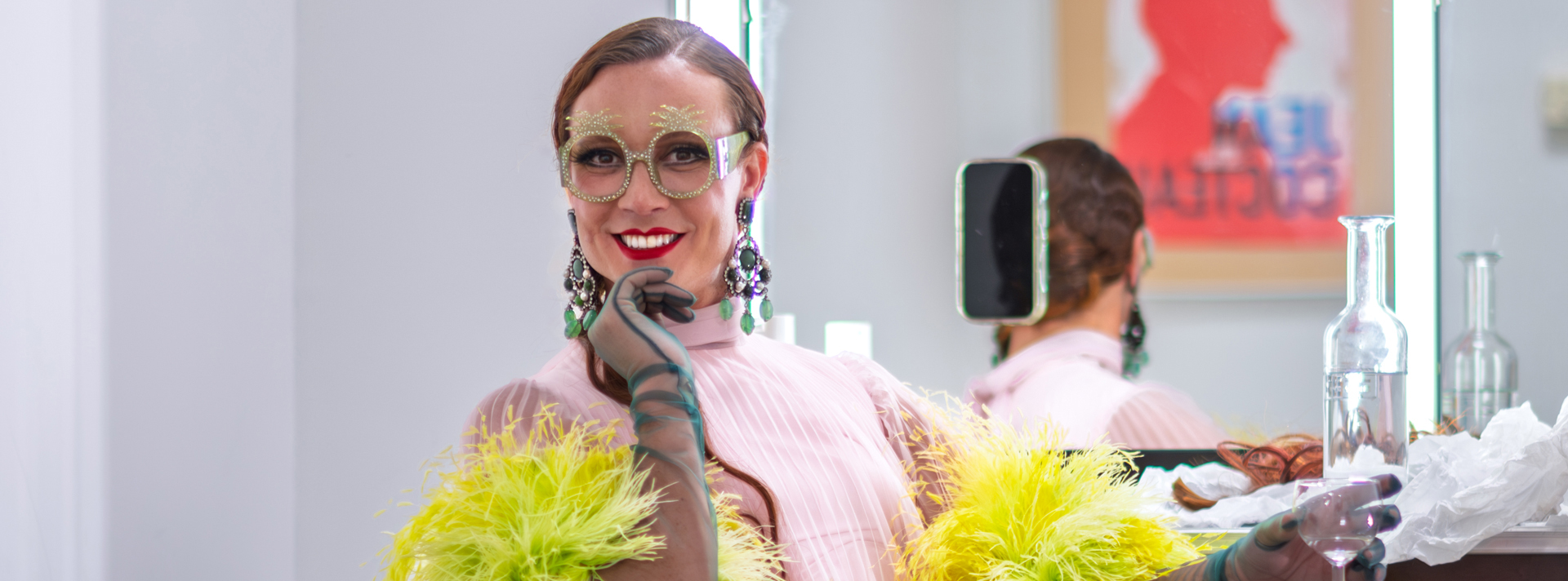
Romain Brau, stage artist: “Cabaret is an art form where you can be anything.”
Romain Brau has just returned from Los Angeles, where he nearly “overdosed on tacos” and where he’s considering opening his own cabaret with a group of friends. He made a quick detour to his Normandy pied-à-terre to retrieve part of his flamboyant wardrobe and enjoy a beef Wellington (although he doesn’t rule out becoming vegetarian one day), before crossing the Marais “made up like a truck” to settle into one of the dressing rooms of the Centre Pompidou’s performance spaces.
On the wall hangs a faded poster from the exhibition "Jean Cocteau, l'enfant terrible" (2004), like a sign. All around are glittering outfits: pink pearl heels, a houndstooth jacket, a green-and-yellow feathered piece that Zizi Jeanmaire wouldn’t have disowned, a wide-brimmed black hat made by his own hand… When asked about his intriguing pineapple-shaped glasses, Romain Brau bursts out laughing: “For Cabaret Extra!, I wanted it to be really pop, visually rich, something that makes you ask: what are those glasses? What is that dress?”
Under his artistic direction, the festival—conceived as a living revue—presents a vibrant series of acts blending writing, performance, and collective celebration. “The Centre Pompidou was my gateway into my dreams,” he recalls, remembering the hours spent revising for his baccalauréat at the Public Information Library.
Romain Brau is a figure both elegant and supple, with a mane of fiery red hair—his signature look. In 2015, he relaunched Madame Arthur, Paris’s first drag cabaret, founded in 1946. For him, it is both a powerful vehicle for emancipation and self-affirmation, far removed from the dusty image he once had: “A 23-year-old poodle and a haggard woman juggling and coughing between cigarettes. In the corner, a battered accordion”, he recalls, a touch sarcastically. But it’s precisely because cabaret lies at the crossroads, at the edges of genres, that it appeals to him—at once dance, song, poetry, and zany storytelling.
We need to laugh today, but the fight must go on—nothing is certain. Cabaret is an art where everything can be said, where you can be anything.
Romain Brau
The artist draws inspiration from the history of great trans and drag icons who made the venue legendary—his “warrior women”, as he calls them. He speaks of Bambi, the stage artist assigned male at birth in Algeria in 1935: “It was incredibly brave to go out like that in the 1950s.” He also cites Coccinelle, another transgender icon, along with the many memories found scattered backstage at Madame Arthur. “They really paved the way for us. Their struggle binds us”, he says, visibly moved. In the 1960s, Madame Arthur was frequented by major figures of gay culture, such as the two Jean—Cocteau and Marais—Marlene Dietrich, and Barbara, who, Romain whispers, was once chastised by Bambi for chatting during her set. For him too, the stage is a form of release: “We need to laugh today, but the fight must go on—nothing is certain. Cabaret is an art where everything can be said, where you can be anything.”
The artist truly rose to public prominence in 2019, transitioning from cabaret to cinema with his striking role as Fred in the comedy The Shiny Shrimps, which follows an unlikely gay water polo team. “I didn’t want to take the role of a transgender artist, since I’m a drag performer. So I proposed a character in transition.” Following the success of this modest-budget film, and its sequel, he’s been busy with film shoots, including an international series with Michael Douglas (Franklin, on Apple TV+), while remaining deeply rooted on stage with his first solo show “Romain Brau Lights Up the Stars” in 2023.
He began modelling at just fifteen, under the jaded gaze of a well-known agency director, before joining the Royal Academy of Fine Arts in Antwerp in the early 2000s, graduating from the fashion programme.
Bullied during his school days in the 1990s, “condemned from the schoolyard”, the young Romain daydreamed over photos of Jean Paul Gaultier’s fashion shows. He watched with fascination his mother—a flamboyant figure-skating coach—do her makeup. From early on, he felt a vital urge to escape his hometown of Varenne-Saint-Hilaire in the Val-de-Marne. Though his parents are now proud of the path they’ve walked together, they were once baffled. When he said he wanted to be a painter, a sculptor, a performer, the reply was: “At worst, you’ll be a flight attendant.”
He began modelling at just fifteen, under the jaded gaze of a well-known agency director, before joining the Royal Academy of Fine Arts in Antwerp in the early 2000s, graduating from the fashion programme. There, he cultivated a deep love and infinite passion for clothing, which he sees as a second skin—a conduit for emotion, even for truth (he has opened several concept stores and designs costumes for choreographer François Chaignaud).
Behind the exuberant, shell-like, stage persona, lies a certain fragility—a quiet shyness. Romain admits he sizes people up through astrology, which he’s passionate about (scoop: he’s a Libra with Sagittarius rising). As he poses for his portraits, he ends with a great burst of laughter: “I never pretended to express anyone other than myself. The stage is just an extension of who I am.” ◼
Related articles
In the calendar
Photo © Pierre Malherbet
